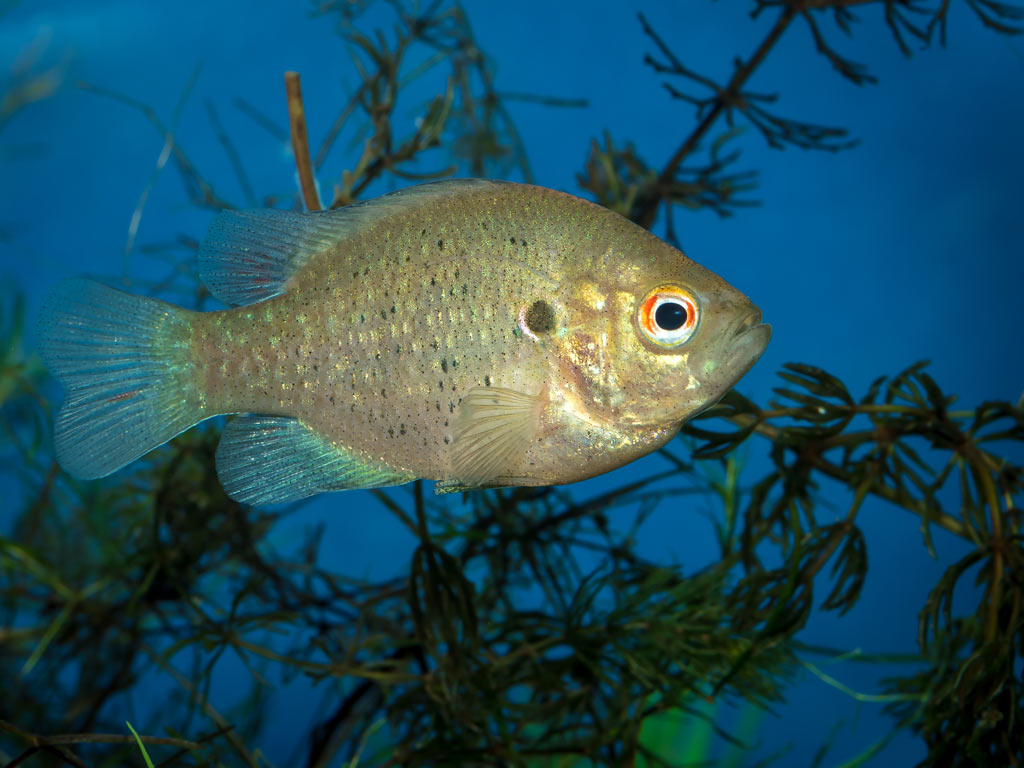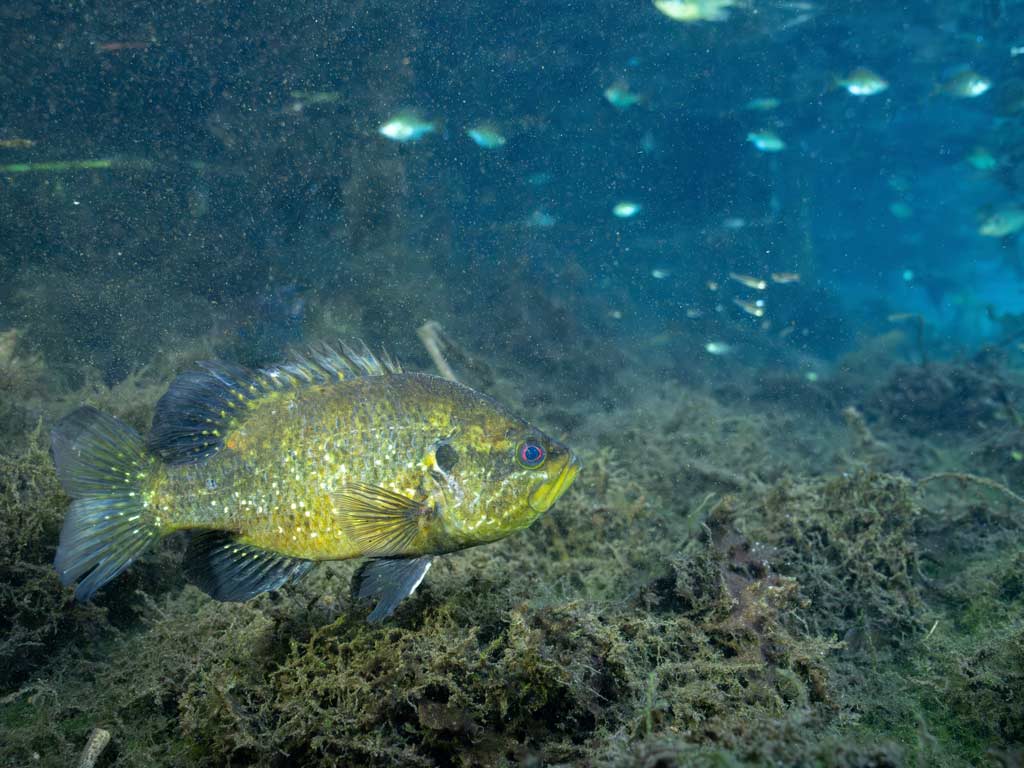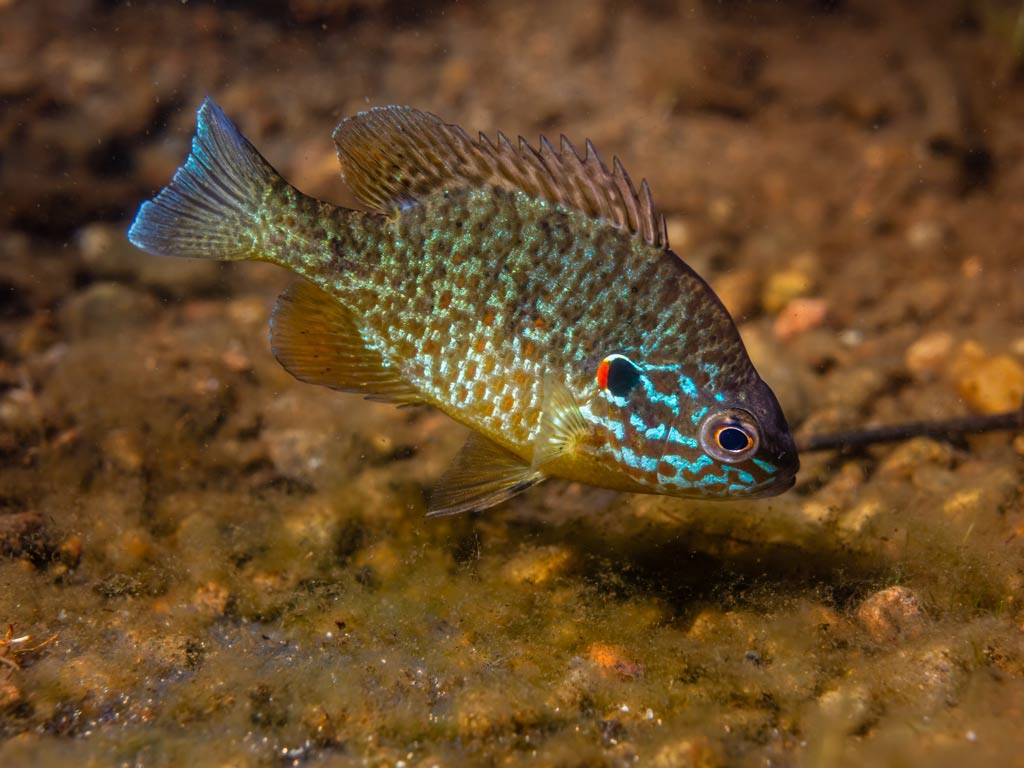Sunfish are among North America’s most popular fish. Anglers and food lovers alike regularly name Sunfish as their favorite species. The only thing is, Sunfish is not a species. It’s an entire group of freshwater fish spread across the continent. So, how do you recognize different types of Sunfish? That’s exactly what you’re going to find out. Read on!
You can tell most Sunfish apart by looking at a few distinctive features. These include:
- The size of their mouth
- The length of their pectoral fin
- Body color
- The opercular flap (the flap at the edge of the gill plate, and the color of its border)
- Position of the eye compared to the jaw
Oftentimes, at least one of these features is noticeably different in a single species of Sunfish. That’s how you’ll tell them apart. That being said, many Sunfish species have been introduced throughout North America and interbred with local populations. These hybrids are a little tougher to tell apart, so we’ll focus on the naturally occurring ones.
Without any further ado, the types of Sunfish in North America are:
Redear Sunfish (Lepomis microlophus)

Average size: 8.5 inches
Redears are native to the Gulf Coast and southeastern US up to North Carolina. These days, you can also find them in the Great Lakes, as well as a few western fisheries.
Redears boast small mouths relative to the size of their bodies. They have dark spots, often in a checkered pattern. Their pectoral fins are elongated, reaching past the eyes when folded forward.
Distinctive feature: A dark inflexible opercular flap, with a red or orange border. This is how Redears got their name.
Green Sunfish (Lepomis cyanellus)

Average size: 5 inches
Green Sunfish are types of Sunfish native to central and eastern USA, as well as Ontario in Canada. You can also find them throughout the US.
These guys have relatively large mouths, with lower jaws extending to the middle of the eye line. The opercular flap is black with a white border, and the pectoral fin is short and rounded.
Distinctive feature: You guessed it, they’re green, although not across the entire body. Their belly side is often bright yellow.
Redbreast Sunfish (Lepomis auritus)

Average size: 10 inches
Redbreasts are native to the east coast of North America from New Brunswick to central Florida. They’ve also been introduced to a number of states and provinces in the US and Canada.
They have wider anal fins than most other Sunfish, with darker roots that turn paler towards the edges. Their pelvic fins are elongated with sharp, scythe-like tips.
Distinctive feature: These guys have two! For one, Redbreasts have dark opercular flaps which are unusually long. Their belly side is also reddish or orange in color.
Bluegill Sunfish (Lepomis macrochirus)

Average size: 8 inches
Bluegills are probably the most popular out of all the Sunfish species in US. Although native to the central and eastern US, you can find them throughout the States.
Bluegills have small mouths, with upper jaws reaching to the lower line of the pupil. Their opercular flap is dark and flexible. Bluegills’ pectoral fins are elongated, reaching past the eye when folded forward.
Distinctive feature: Bluegills’ soft dorsal fin has a single black spot.
Warmouth Sunfish (Lepomis gulosus)

Average size: 7 inches
Warmouth Sunfish are types of Sunfish native to the Great Lakes and the entire Mississippi River and its tributaries. They’re not widely present outside of these places.
If Warmouths didn’t have such big mouths, you could easily confuse them with Smallmouth Bass. These guys have red eyes, with stripes stretching from the eyes to the opercular flap. The flap is small and dark, with a red border. Warmouths boast a short, rounded pectoral fin that does not extend beyond the eye.
Distinctive feature: Apart from the red eye, male Warmouths can have a single, red to orange spot on their rear dorsal fin.
Pumpkinseed Sunfish (Lepomis gibbosus)

Average size: 8 inches
Pumpkinseeds are native to the Atlantic coast of North America from New Brunswick to South Carolina. You can also find them in central and northwestern USA.
Pumpkinseed Sunfish have very small mouths relative their body size. The opercular flap is flexible, with a white border that has a red spot on the edge. Their pectoral fins are light-colored, ranging from bright yellow to white.
Distinctive feature: Pumpkinseeds have blue lines throughout their gill plates.
Longear Sunfish (Lepomis megalotis)

Average size: 9 inches
Longear Sunfish are native to eastern North America, stretching from the Great Lakes all the way to Florida and Louisiana.
Longears have noticeably longer pelvic fins than most other types of Sunfish. They point almost vertically downward.
Distinctive feature: An elongated dark opercular flap with a dark border, as well as bright blue spots across the body.
And Many, Many More
This has been a rundown of some of the most common types of Sunfish. There are a number of other Sunfish species, and countless hybrid combinations across North America. All of the species we mentioned react well to pretty much any type of bait or lure, so they’re a great choice if you’re looking to hook your kids on fishing. One thing’s for sure though – whichever of these Panfish you get your hands on, you’re in for a tasty treat.
Your turn. Which type of Sunfish is your favorite? Are there any common Sunfish species you think should have made the list? Let us know in the comments below.
